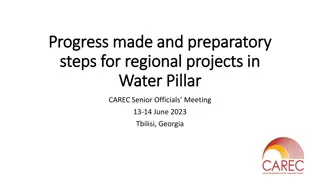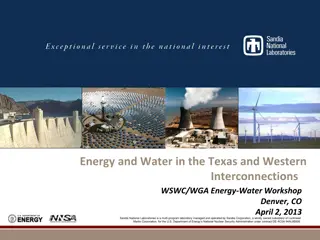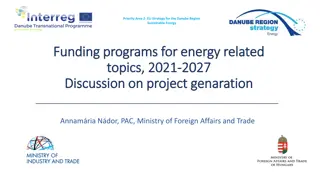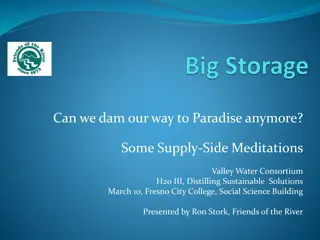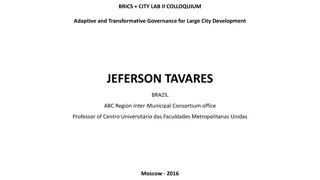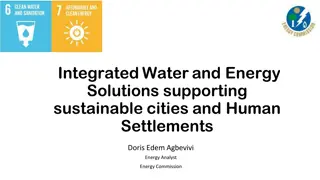Sustainable Water and Energy Solutions in Brazil
This document by Igor Ribeiro, Substitute Director at the Ministry of Mines and Energy in Brazil, presents estimates on water and energy solutions, highlighting Brazilian hydrographic basins, reservoirs, energy diversity, and opportunities amidst recent drought events. It addresses water security, infrastructure, and the evolving energy matrix with multiple sources.
Download Presentation

Please find below an Image/Link to download the presentation.
The content on the website is provided AS IS for your information and personal use only. It may not be sold, licensed, or shared on other websites without obtaining consent from the author.If you encounter any issues during the download, it is possible that the publisher has removed the file from their server.
You are allowed to download the files provided on this website for personal or commercial use, subject to the condition that they are used lawfully. All files are the property of their respective owners.
The content on the website is provided AS IS for your information and personal use only. It may not be sold, licensed, or shared on other websites without obtaining consent from the author.
E N D
Presentation Transcript
Igor Ribeiro Substitute Director Substitute Director Ministry of Mines and Energy - Brazil Global Symposium on Sustainable Water and Energy Solutions Sustainable Water and Energy Solutions & Energy Case Studies Sustainable Water and Energy Solutions & Energy Case Studies Este documento foi preparado pelo MME e apresenta as melhores estimativas com base nas informa es dispon veis. N o h garantia de realiza o para os valores previstos ou estimados. O conte do apresentado est sujeito a tratamento e interpreta es. 06/13/2022 06/13/2022
Brazilian Hydrographic Basins Human consumption / sanitation Animal consumption Environmental Agriculture / irrigation Energy Industrial Transportation / waterway Fishing and aquaculture Entertainment Geography: water for multiple uses and to support Brazilian socioeconomic development
Reservoirs: water security in a climate change context Water storage capacity in billions of m Water storage capacity in m per capita Source: Grey e Sadoff, 2007 Source: ANA, 2022 Infrastructure: high water storage capacity in hydroelectric power plant reservoirs
Energy diversity Nuclear 2% Nuclear 1% Wind 4% Distributed generation 3% Petroleum and coal 11% Coal 3% Solar (non-DG) 2% Wind (non-DG) 10% Petroleum 7% Nuclear 1% Biomass 2% Coal 2% Biomass Petroleum 9% 5% 81 GW 2001 134 GW 2014 186 GW 2021 Biomass 8% Natural gas 9% Hydropower 67% Hydropower 61% Natural gas Hydropower 85% 8% + 65% + 39% +4.004 MW/year +7.428 MW/year Infrastructure: electricity generation matrix with multiple sources and relevant renewable participation
Recent drought events The flows have changed % Long-term average (91 years) Sudeste/Centro-Oeste (SE/CO) and Nordeste (NE) Subsystems Historical Average 130 120 Affluent natural energy 110 100 90 80 70 60 50 40 30 20 10 0 SE/CO NE Fonte: ONS Prevalence of values below the historical average in the last years
Recent drought events Hydric balance (2020) Drought events increase water use conflicts; Adaptation of water uses was necessary; Water stored in the reservoirs was fundamental to deal with the scarcity; Energy, environmental and water resources policies needed to be articulated at the new operating point; New rules for the operation of hydroelectric power plant reservoirs were established. Source: ANA, 2022
Facing recent drought events Initiatives to improve water-energy nexus: Reservoir Recovery Plan: established by Law (Lei n 14.182/2021); Programs to revitalize the water resources of hydrographic basins: established by Law (Lei n 14.182/2021); Evaluation and increase in the risk aversion of computational models to support the optimization of the electrical system.
Regulatory stability Operating rules in extreme hydrological events (Brazilian electricity sector is prepared to deal with these rules) Structural alteration of operating rules and water use rights
Opportunities from this point forward Legal certainty for investments Regulatory stability with impact analysis Legal instruments to support possible water rights reallocations More water for Brazilian socioeconomic growth
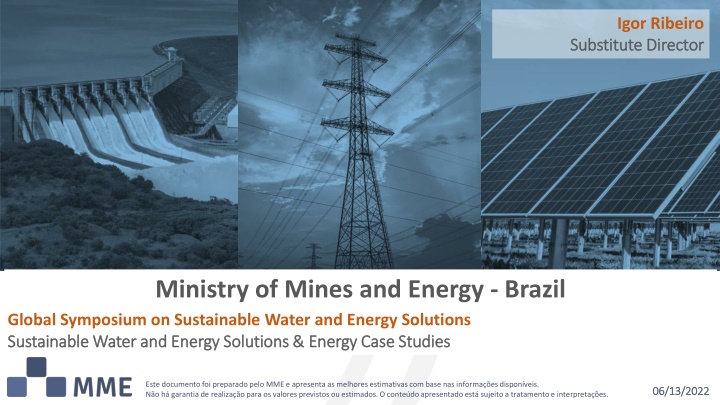



![Halal_Chicken_from_Brazil-_Ensuring_Quality_and_Authenticity[1]](/thumb/86918/halal-chicken-from-brazil-ensuring-quality-and-authenticity-1.jpg)

